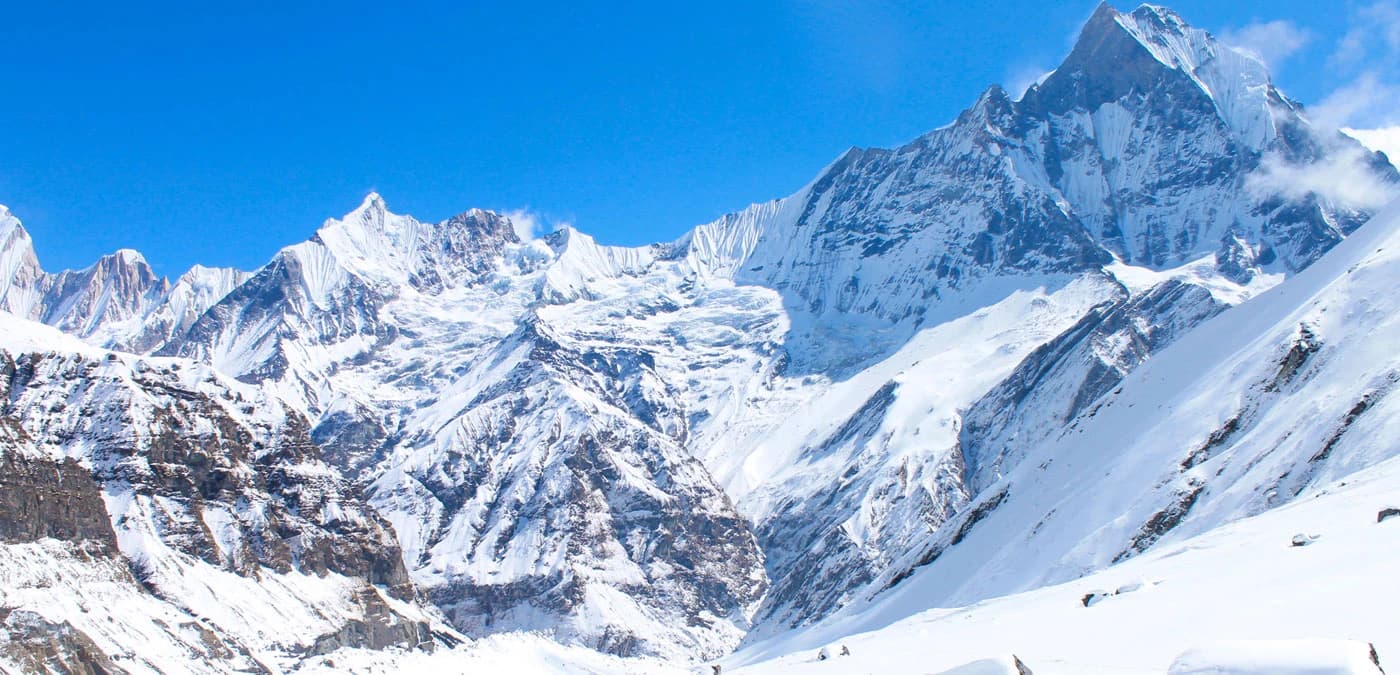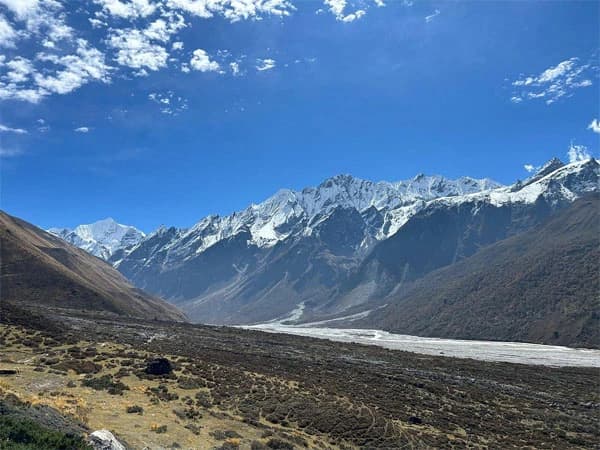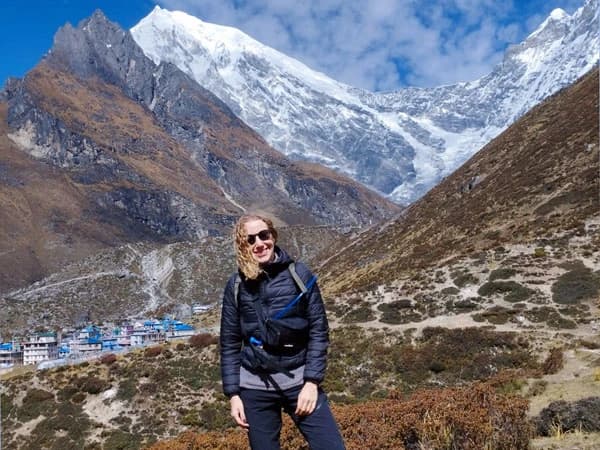The Annapurna Region is one of the most famous trekking region in Nepal. It offers diverse landscapes, breathtaking Himalayan views, and cultural exploration. Trekking in this region takes you through lush landscapes, culture, and unique experience. The Annapurna Region in Nepal is a dream spot for anyone craving mountain adventures and cultural vibes. Nestled in the heart of the country, this region is gifted with jaw-dropping peaks like Annapurna I, Machapuchre, and Dhaulagiri. Short trails like Ghorepani Poon Hill serve up sunrise views without the grind, while the longer trails like Annapurna Circuit lures experienced trekkers with its loop around the mountain including though climb over the Thorong La Pass. Then there is a base camp route which drops you into a valley encircled by icy peaks. Whether you are up for a quick hike or weeks long challenge, there is something for everyone.
Best Treks in Annapurna
Famous trekking routes in Annapurna region
- Annapurna Base Camp Trek
- Annapurna Circuit Trek
- Ghorepani Poon Hill Trek
- Mardi Himal Trek
- Khopra Danda Trek
- Tilicho Lake Trek
- Nar Phu Valley Trek
Annapurna Base Camp Trek
The Annapurna Base Camp (ABC) Trekis a classic Himalayan walk that takes you from lush, green foothills up into a high‑altitude amphitheater of snow‑capped giants. You usually start in Nayapul or Phedi, following a gentle trail beside the Modi Khola. Bright rhododendron and oak forests line the path, and you’ll cross wooden suspension bridges swaying over roaring rivers.
On the first couple of days you’ll pass through villages like Ghandruk and Chhomrong. These small stops have cozy teahouses where you can rest on wooden benches, warm your hands by a wood stove, and fill up on hearty dal‑bhat. Beyond Chhomrong the trail narrows and climbs more steeply, winding through bamboo thickets and past tumbling waterfalls.
After Dovan and Himalaya (both simple camps with a handful of lodges), you reach Machhapuchre Base Camp your first real taste of alpine views. Jagged peaks glow at sunset, and prayer flags flap overhead in the cold breeze. From there it’s one more push to ABC itself, sitting at about 4,130 m. The final stretch crosses rocky moraines, and when you round the corner you’re greeted by a huge bowl of peaks Annapurna I, II, Hiunchuli and Gangapurna all stacked around a frozen glacier lake.
You’ll need an Annapurna Conservation Area Permit and a TIMS card, plus good boots, warm layers and sun protection. Plan for six to ten days depending on your pace, and take time to hydrate and rest as you climb. At ABC, breakfast by the tent‑like lodges as the morning sun paints the mountains gold, it’s a simple, unforgettable moment that makes every step worthwhile.
Annapurna Circuit Trek
The trek to Annapurna Circuit feels like a great loop through changing worlds. You begin down in the green, misty foothills maybe at Besisahar or Bhulbhule, then walk beside the Marsyangdhi River past terraced fields and small villages where kids wave and farmers tend goats. The trail climbs gently at first, winding through oak and rhododendron forests full of birdsong.
Soon you’re in the high country. Mani walls and prayer flags mark the way as you gain altitude, stopping in teahouses at Dharapani, Chame and Yak Kharka for steaming dal‑bhat and simple beds. In Manang, most people rest a day to dodge altitude sickness, wandering its winding alleys or sipping butter tea while gazing up at snowy summits.
Beyond Manang the valley turns into unambiguous, boulders, scree and wind‑cut cliffs until you camp below Thorong La. The pre‑dawn climb to the pass (5,416 m) is steep and cold, but sunrise on the rim lights up the Mustang side in pink and gold. On the other side, the air is drier and warmer as you drop into Muktinath which attracts pilgrims from Tibet, and then you will move on to dusty Jomsom with its apricot orchards.
From Jomsom you can fly back to Pokhara or keep walking through Marpha and Tatopani, where hot springs ease sore muscles. You’ll need an Annapurna Conservation Area Permit (ACAP), a TIMS card, warm layers, good boots and a daypack. Plan for about two weeks, though you can speed up or slow down however you like. It’s a bit of everything like culture, nature and that unforgettable pass wrapped into one awesome trek.
Ghorepani Poon Hill Trek
The Ghorepani Poon Hill Trek is a gentle, classic Himalayan journey perfect if you want big views without multi‐week slog. You start in the lush foothills around Nayapul, winding up stone steps through terraced farms and rhododendron forests. After a day of steady climbing you’ll reach Ulleri, a village built into the hillside, where your legs get familiar with the switchbacks.
On day two you push on to Ghorepani (2,750 m), passing through shade‑dappled woods and small tea‑house villages. In spring, pink and white rhododendrons carpet the slopes; in autumn, the air is crisp and clear. Ghorepani itself feels like a cozy mountain village with simple lodges, wood‑burning stoves, and prayer flags snapping overhead.
The grand moment comes just before dawn on day three. You’ll set off in the dark for Poon Hill (3,210 m), a short but steep 45‑minute climb. By the time the sun peeks over the Annapurna and Dhaulagiri ranges, you’re standing on a rocky ridge watching peaks light up in gold and rose. It’s one of the most accessible Himalayan sunrises you can get.
After soaking in the panorama, you descend back to Ghorepani for breakfast, then either retrace your steps or loop down through Ghandruk i.e. a traditional Gurung village with narrow alleys and friendly locals to finish at Pokhara’s lakeside. You’ll need an Annapurna Conservation Area Permit and a TIMS card, plus warm layers, a headlamp for the early‐morning climb, and good trekking shoes. Even if it’s your first multi‐day trek, Poon Hill delivers Himalayan magic in just three to four days.
Mardi Himal Trek
Mardi Himal Trek is a quiet, off‑the‑beaten‑path journey that starts just outside Pokhara. You’ll leave the bustle of Lakeside behind and climb through rhododendron forests alive with bird song. The trail winds past small farms and traditional stone houses until you reach Forest Camp, a cluster of teahouses nestled under towering oaks.
From Forest Camp, the path gets steeper as you head toward High Camp. Trees give way to open slopes strewn with boulders and prayer flags fluttering in the breeze. High Camp (around 3,550 m) offers your first big Himalayan view Machhapuchre fish‑tail peak backed by Annapurna South and Hiunchuli. It’s a perfect spot to rest and watch the light shift on the giant walls at sunset.
The highlight comes next morning, before dawn, when you push up to the Mardi Himal Base (4,500 m) and the small viewpoint ridge above it. At sunrise, the sky turns pink behind fishtail, Annapurna, and Dhaulagiri, and the world feels suspended between clouds and snowy pinnacles. On the way down you can loop back through Siding Village or return via the same trail, descending past terraced fields and local farms. You’ll need an Annapurna Conservation Area Permit and a TIMS card, plus sturdy boots, warm layers, and water ideal for anyone who’s done a few days of hiking and wants peaceful views without the crowds.
Khopra Danda trek
Khopra Danda Trek takes you off the busy Annapurna Circuit and up onto a gentle ridge with some of the best sunrise panoramas in Nepal. You begin near Nayapul or Ghandruk, following terraced fields and rhododendron forests until you strike off‑trail toward Khopra. After crossing a small ridge you’ll pass through quiet villages like Dipla and Tadapani, where the air is thin but the hospitality is warm simple tea houses, home‑cooked dal‑bhat, and nights spent under wool blankets.
The real climb kicks in above Tadapani as the forest thins and views of Machhapuchre (Fishtail), Annapurna South, Dhaulagiri, and Nilgiri peaks open up. You’ll gain about 1,000 m over loose stone paths to reach Khopra Danda (ridge) at around 3,660 m. Waking before dawn here is magical: the sun spills golden light across the Himalayan giants, and you feel like you’re floating above the clouds.
If you want an extra side‑trip, hop over to Khayer Lake, a sacred high‑altitude tarn hidden just above the ridge. It’s a short but steep scramble, and when you peer into that icy pool with snow‑capped peaks reflected on its surface, it feels like a secret gift. All you need is your Annapurna Conservation Area Permit, good boots, warm layers, and plenty of water. The trail is moderate better if you’ve done a few multi‑day hikes but the gentle ridge walking and remote villages make Khopra Danda feel like a true Himalayan hideaway.
Nar Phu Valley Trek
The Nar Phu Valley Trek feels like stepping into a different world. You leave the busy trails of Annapurna behind and follow a quiet river valley, climbing slowly through pine forests and terraced fields. Every now and then you’ll pass stone houses with smoke curling from their chimneys, and you’ll hear the soft chime of prayer flags overhead.
As you gain altitude, the path narrows and the walls of the gorge close in. You’ll cross wooden bridges and duck under ancient mani walls carved with Buddhist mantras. In Nar and Phu the only two villages here, life hasn’t changed much in centuries. Guests stay in simple teahouses, share dal‑bhat with local families, and learn a few words of Tibetan‑style Nepali. It’s common to wake before dawn and watch yak caravans set off through misty fields.
The biggest test comes at Kang La Pass (5,300 m). The last stretch is steep and rocky, but when you reach the top, the valley opens up to sweeping views of Annapurna II, Himlung and the jagged Manaslu range in the distance. After that, the trail drops down into deep, dry canyons and eventually links back to more popular routes. You’ll need a restricted‑area permit and a guide, and some basic trekking gear, but no heavyweight expedition kit. If you’ve done a few mountain walks before, you’ll find Nar Phu’s quiet trails and simple hillside villages a gentle, rewarding adventure.
Tilicho Lake Trek
Tilicho Lake Trek winds you from the dry hills above the Marsyangdhi River up into a high‑altitude world of jagged peaks and frozen lakes. You start in the village of Manang, climbing past mani walls and prayer flags, and follow a winding trail alongside the roaring Thorong Khola. Once you leave the main Annapurna circuit, the path narrows, dusty cliffs rising on one side, steep drop‑offs on the other.
After a couple of days, you reach Tilicho Base Camp, a handful of teahouses perched below rocky slopes. From here, the morning hike to Tilicho Lake (4,919 m) is the highlight: the trail kicks up loose scree, then twists through narrow gullies. When you round the final ridge, a pale blue lake appears, ringed by ice and crowned by Annapurna’s snowy flanks. It feels like stepping onto another planet.
You’ll need an Annapurna Conservation Area Permit and a TIMS card, plus basic high‑altitude gear: warm layers, a sleeping bag rated for –10 °C, good boots, and trekking poles. The mountain air is thin, so go slow and drink plenty of water. In spring (April–May) or autumn (October–November), weather is stable and trails are mostly clear. After soaking in the lake’s mirror‑like calm, you loop back toward the main circuit perhaps via Yak Kharka and Thorong La Pass feeling like you’ve touched the sky without the crowds.
Useful information
Trekking permits needed to trek in the Annapurna Region
While trekking in the Annapurna region, you will need various trekking Permits. As this region has many restricted and protected areas you will need following permits to Trek.
- Annapurna Conservation Area Entry permit
This trekking permit is mandatory for all trekkers wanting to explore the beauty of the Annapurna Region. As you need to pass through parts of the Annapurna Conservation Area you will need these permits in various check posts. you can get this permit through the registered Trekking Agency in Nepal. It will cost you NPR 3000 to obtain this permit.
- Trekkers Information Management System Card (TIMS)
This card helps to track the movement of the trekkers and ensure their safety. It is mandatory to get this trekking permit in order to trek in the Annapurna region. This permit can be collected by a registered trekking agency in Nepal with documents like information of trekkers, guide, and trekking route. It will cost NPR 2000 for foreigners whereas NPR 1000 for SAARC countries.
- Mardi Himal Trek Permit
This permit is essential to trek the Mardi Himal. It costs NPR 3000 to obtain this Permit. Coordinating with registered trekking agency in Nepal will help you to get this permit easily.
- Nar Phu Restricted Area Permit
This permit is key to trek the hidden gem of Annapurna region i.e. Nar Phu Valley. You can obtain the Nar Phu Restricted Area Permit from Immigration Department in Kathmandu through the registered trekking agency in Nepal. The price for this permit depends on the season as it will cost $100 per person during autumn while $75 during other seasons.
- Upper Mustang Restricted Area Permit
This is the mandatory trekking permit to enter the Upper Mustang Restricted Area. The restricted area starts from Kagbeni and it is the first check point where you will have to show this permit. It will cost $500 to get this permit for 10 days and $50 per additional day. This permit cannot be obtained individually; you must obtain this permit through registered trekking agency in Nepal.
Best season to Trek the Annapurna Region
One of the best time to trek the Annapurna region is during Spring and Autumn. These seasons offers best trekking atmosphere with clear skies and good visibility. These season are best time to explore the beauty of the Annapurna region in a safe and comfortable trekking environment. Spring offers beautiful rhododendron bloom throughout the journey whereas autumn offers festive vibes.
Spring offers stable weather conditions with breathtaking views. You will trek through rhododendron forest bloomed in pink, red, and white spreading fragrance all over the trekking trail. The Himalayan views are also clear and with good trekking environment. The trails are also well maintained making it more accessible.
Autumn is the peak trekking season in the Annapurna region of Nepal. As this is one of the popular trekking route in Nepal, many travelers visit this region during autumn season. Autumn offers beautiful Himalayan views, clear skies and stable weather conditions. It is also the festive season in Nepal as big festivals like Dashain and Tihar falls during this season. You can know more about the cultures of people if you choose to trek during these seasons.
Note: Avoid the monsoon (June–August) when trails get muddy and views can be cloud‑bound, and brace for cold nights if you trek in winter.
Safety tips
Here are practical safety tips for trekking in the Annapurna region:
- Get proper permits: Carry your Annapurna Conservation Area Permit (ACAP) and TIMS card at all times, they’re checked at trail checkpoints.
- Plan acclimatization days: Build in at least one full rest day for every 300–500 m of altitude gain above 3,000 m to reduce altitude sickness risk.
- Stay hydrated: Drink at least 3–4 liters of water per day. Treat or filter water from streams to avoid gastrointestinal illness.
- Pack layers: Weather changes quickly so use moisture‑wicking base layers, a warm mid‑layer, and a waterproof outer shell.
- Invest in boots: Sturdy, broken‑in hiking boots with good ankle support will help prevent blisters and sprains on rocky trails.
- Use trekking poles: Poles reduce stress on knees during descents and improve balance on uneven terrain.
- Check weather forecasts: Avoid crossing high passes in heavy snow or storms; timing crosses (like Thorong La) for clear mornings lowers avalanche risk.
- Watch for altitude symptoms: Learn early signs like headache, nausea, dizziness and descend immediately if symptoms worsen or don’t improve with rest.
- Travel with a guide or group: Local guides know changing trail conditions, weather patterns, and where to find help in emergencies.
- Carry a basic first‑aid kit: Include blister plasters, pain relievers, altitude‑sickness tablets, antiseptic wipes, and any personal medications.
- Tell someone your itinerary: Leave a copy with family or your hotel; check in regularly so rescuers know where to start looking if you don’t arrive.
- Start early each day: Trails are safest in the morning as rock falls, slippery snow, and afternoon storms are more common later.
- Respect river crossings: Unstable bridges and fast currents can be dangerous cross one at a time, keep your poles ahead to probe depth, and unclip daypack straps.
- Protect against sun and cold: Use sunscreen (SPF 30+), sunglasses with UV protection, and warm hat and gloves at higher altitudes.
- Eat energy‑rich meals: Plenty of carbs and protein help maintain strength in thin air, dal‑bhat provides good fuel on Nepali tea‑house menus.
- Carry extra food and water: Unexpected delays happen, so it is always better to have an additional day’s worth of supplies.
- Know emergency numbers: Nepal’s mountain rescue (dial 112) and local airline offices (for helicopter evacuations) should be saved in your phone.
- Keep electronics warm: Batteries drain faster in cold so store phones, headlamps, and GPS devices inside your jacket when not in use.
- Follow trail markers: Painted stones or small flags mark official routes straying off‑trail increases risk of getting lost or encountering unstable ground.
- Listen to your body: Fatigue and overexertion lead to mistakes, if you feel too tired or uneasy about conditions, slow down or stop for the day.





